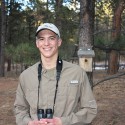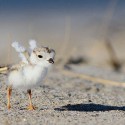 Photo ©
Keith Williams
Photo ©
Keith Williams

Young NestWatcher Has Spark
“Just as the numerous eggs inside the nest boxes are preparing to hatch, disaster strikes the Black Forest. A destructive wildfire is ravaging the woods, destroying large swaths of habitat and homes. Ignited early in the afternoon of June 11, an uncontrollable wildfire is raging toward my nest box trail. I was forced to evacuate my home as a massive smoke plume engulfed my beloved woods. The fire continues to grow, and I feel helpless as I watch my forest burn. I fear many things from this fire, but utmost is my fear for the 63 eggs on my nest box trail so close to hatching. As I write now, I watch from a hotel window helicopters and planes dumping slurry and water into the hazy smoke plume. The entire city smells like smoke. I fear now that my efforts to provide the birds of Colorado safe places to raise their young were ended in only a few days of destruction. I do not know if the nest boxes still stand.”
This is an excerpt from a firsthand account written by 15-year-old NestWatcher Alec Wyatt. Alec came to the Lab of Ornithology for the 2014 Young Birder’s Event held in July. He had earned a coveted seat among 16 of the most promising young ornithologists around the world. Earlier this year, he took home the American Birding Association’s 2014 Young Birder of the Year award. This excerpt was taken from the 150-page book that helped him win these honors, detailing his experiences managing a nest box trail, involving local school children in bird stewardship, and chronicling the unexpected turn of events when a wildfire broke out in his Colorado hometown in June 2013.
As Alec watched all his hard work of building and installing nest boxes literally go up in smoke, his concern was not for material things, but for the birds he had nurtured to the point of nearly hatching. The story has a happy ending for the birds, though. When Alec was allowed to return to the evacuated area 15 days later, he could finally learn the condition of his nest box trail:
“My surprise was indescribable when I discovered 47 healthy baby birds, growing rapidly within the smoky nest boxes. All 36 boxes survived the blaze, even though some sustained damage. I could not believe my eyes as I discovered box after box unharmed, even though the land beneath them and around them was charred. In many cases, healthy nestlings were being raised in boxes scorched by flames. That means the parent birds tended their nests even as the fire burned underneath their eggs.”
Alec is now working with NestWatch to analyze his data on nesting success on the trail before, during, and after the Black Forest wildfire. He plans to attend college to study birds and ecology when he graduates from high school, and do we know just the university for him!

Home Tweet Home Winners
On August 4, NestWatch announced the winners of the Home Tweet Home photo contest which ran throughout July. With a total of 730 submissions, voters certainly had their work cut out for them. In the end, our judges selected the first and second place winners from among four category winners chosen by popular vote. Here they are:
- Cutest Baby (First place winner): Piping Plover chick by Kim Caruso
- Best Nest (Second place winner): White-eyed Vireo nest by Sheri Douse
- Beautiful Eggs (Category Winner): Robin’s Eggs by Linda Bowers
- Feeding Time (Category Winner): Brown Thrasher fledgling and parent by Elizabeth McWilliams
Judges also selected 17 Honorable Mentions that stood out as their favorites. See the gallery of honorees online. We thank everyone who submitted their best work, as well as voters who took time to vote for photos. It was a successful first contest, and we are already looking forward to next year.

Empty Nests, Full Hearts
As nesting season is winding down, some of us are starting to feel that empty nest syndrome setting in. Some participants may still have active nests, but the frenzied rush of spring and summer has come and gone, and the gradually shortening days signal the end of August and the onset of migration.
As birds prepare to embark on their journeys south, it’s time to start entering your data for NestWatch. Birds may be leaving, but the nest monitor’s job is not finished yet; you’re still needed! Log in today, and tell us what you saw this summer. It is especially helpful if we have all 2014 data by the years’ end for timely analysis.